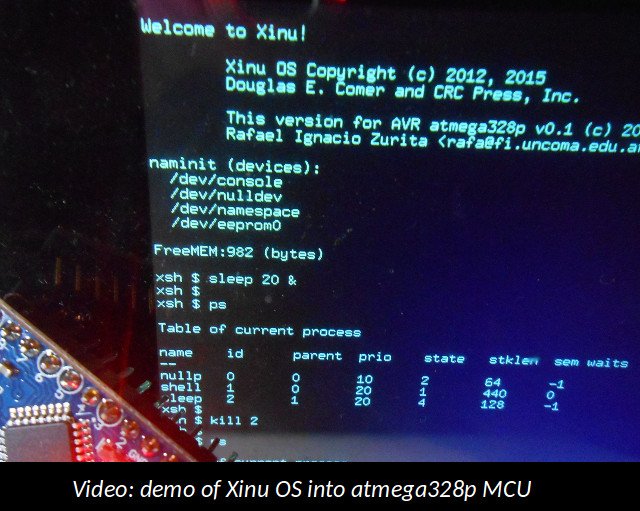
The xinu-avr project is a Xinu Operating System subset, modified to run on an AVR atmega328p microcontroller (e.g. Arduino boards).
At present, the core pieces of Xinu are working, so you can already integrate it in the development of multi-tasking embedded systems (you will also need any bare AVR MCU, or Arduino board, of course).
For lovers of "because small is beautiful" (FusixOS, retrobsd, unix in microcontrollers, etc) this project provides a user interface example as well: The Xinu shell and some tiny versions of utilities like echo, a text editor, a basic interpreter, ps, kill, free, date, cal, and some more. Check the demo video if you want to see a xinu-avr session in a little AVR MCU (like a retro computer system).
The source code is comprise of:
Xinu is a small, elegant, and easy to understand operating system, originally developed by Douglas Comer for instructional purposes at Purdue University in the 1980s. Since then it has been ported to many architectures and hardware platforms. Xinu uses powerful primitives to provides all the componentes and the same functionality many conventional operating sytems supply. Because the whole source code size is small, Xinu is suitable for embedded systems.
The Xinu Operating System includes: dynamic process creation, dynamic memory allocation, real-time clock management, process coordination and synchronization, local and remote file systems, a shell, and device-independent I/O functions.
The Xinu Operating System is documented in the book D. Comer, Operating System Design - The Xinu Approach, Second Edition CRC Press, 2015. ISBN 9781498712439
Many sites defines Xinu as a free Unix system, or similar statements. It is not. Xinu differs completely from the internal structure of Unix (or Linux). For academic purposes Xinu is smaller, elegant, and easier to understand. Applications written for one system will not run on the other without modification. Xinu is not Unix.
Xinu originally ran on Digital Equipment Corporation LSI 11's with only 64K bytes of memory, at the end of 1979 and the inning of 1980. Over the years Xinu have been expanded and ported to a wide variety of architectures and platforms, including: IBM PC, Macintosh, Digital Equipment Corporation VAX and DECStation 3100, Sun Microsystems Sun 2, Sun 3 and Sparcstations, and for several ARM, MIPS and x86 embedded boards. It has been used as the basis for many research projects. Furthermore, Xinu has been used as an embedded system in products by companies such as Motorola, Mitsubishi, Hewlett-Packard, and Lexmark. There is a full TCP/IP stack, and even the original version of Xinu (for the PDP-11) supported arbitrary processes and network I/O.
There are current versions of Xinu for Galileo Intel boards, ARM Beagle Boards, several MIPS platforms, and for x86 PC hardware and virtual machines.
There is just one git repository, and it has everything (git). The list below is just for convenience:
Acknowledgments
Current official Xinu versions are designed for ARM, MIPS and x86 architectures . The hardware differences between those and the ultra small AVR microcontroller required changes to some low-level data structures of Xinu, mainly using the FLASH memory in the AVR MCU, for keeping several read-only data structures, previously in RAM. Also, several limits were imposed, so the read-write data structures fits into the SRAM AVR memory. The Xinu version for AVR atmega328p has the core functionality of Xinu, and provides some extensions, including an eeprom file system and several UNIX like utilities for the Xinu shell.
This MCU has just 2KB of SRAM, 32KB of FLASH memory, and 1KB of EEPROM. The Xinu version for AVR uses 12KB of FLASH and 0.9KB of RAM, so there is still 50% of room (SRAM and FLASH) for the embedded application running on Xinu (concurrent processes).
So this project might be stimulating and very fun for lovers of embedded systems development and operating system internals.
Notes about the port:
Douglas Comer is a Professor of Computer Science at Purdue University who was inducted into the Internet Hall of Fame on September, 2019.
As one of the earliest TCP/IP and internetworking researchers, Comer wrote the first series of textbooks explaining the scientific principles underlying the design of the Internet and its communications protocols, providing some of the earliest formal guidance for building efficient networks and applications that use the Internet. Comer's three-volume textbook series, Internetworking with TCP/IP, written in 1987, is widely considered to be the authoritative reference for Internet protocols. The series played a key role in popularizing Internet protocols by making them more understandable to a new generation of engineers and IT professionals.
Prof. Douglas Comer designed and developed the Xinu operating system in 1979-1980.